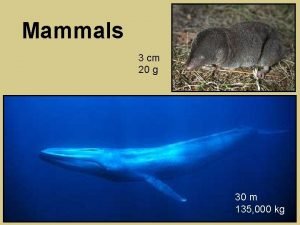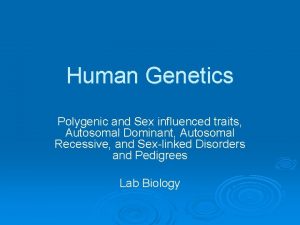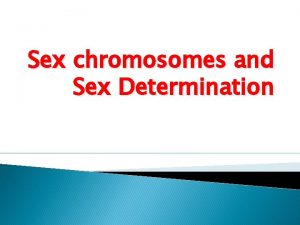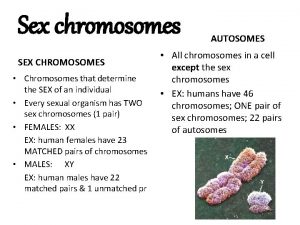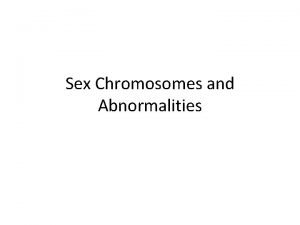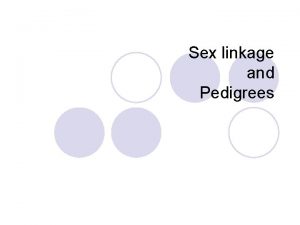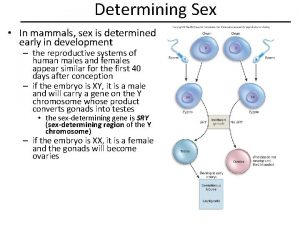X and Y Chromosomes Sex Chromosomes Mammals use













- Slides: 13

X and Y Chromosomes

Sex Chromosomes • Mammals use a chromosomal method of determining sex: XX is female and XY is male. • Birds use a ZW system: ZZ is male and ZW is female. – the evolutionary origin of mammalian and bird sex chromosomes is different • Some reptiles use developmental temperature to determine sex: depends on the species, but hot is male and cold is female in some. • Drosophila also use an X-Y system (i. e. male is XY and female is XX), but the evolutionary origin and mode of action of Drosophila sex chromosomes is different form mammalian.

X and Y Homology • • The X is a large submetacentric chromosome with many genes on it, most of which are unrelated to sex. The Y is acrocentric and much smaller. Only 83 active genes on the Y, most of which are related to sex determination and spermatogenesis. However, many homologues exist between the X and the Y, with the Y gene often a pseudogene. This suggests a common evolutionary origin. The tips of the X and Y pair in meiosis, and undergo crossing over. – These regions are called the pseudoautosomal regions. , PAR 1 and PAR 2. – a crossover in PAR 1 is necessary in male meiosis to get proper segregation of the chromosomes.

Y Chromosome Evolution • • The X and Y started off as the same chromosome, but the Y has gradually lost the ability to recombine with the X. A series of inversions has occurred. Crossing over between an inversion and a normal chromosome results in dead offspring. Based on X-Y homologous genes, looking at synonymous substitution rates. They vary in groups which suggests blocks of chromosome that became unable to share alleles between the X and Y. Muller's ratchet. If you don't have crossing over, mutations accumulate. C-O allows chromosomes with no mutations to be created during meiosis. The same phenomenon is seen with the Y in Drosophila and the W in birds.

Ks vs. Y Position

Gene Conversion on the Y • Recall that gene conversion is an alternative outcome of crossing over in meiosis. – In gene conversion, only a short region, 1 -2 kbp is switched to the alternate allele. – Gene conversion can occur within a chromosome it there are homologous regions on it. – This is especially true of unpaired chromosomes like the X and Y in humans. • On the Y are 8 large palindromic sequences (inverted repeats), from 9 kbp to 1. 45 Mbp. Each gene in this region is thus duplicated. Gene conversions between these palindromes keeps the two copies almost identical. – This gets around Muller’s ratchet: if mutation inactivates one copy of the gene, there is another good copy, and in some offspring both copies will be converted to the good version. Offspring where both copies are bad will be sterile or die. – Genes in these palindromes are all involved in spermatogenesis.

Dosage Compensation • • How can females have 2 X’s and males only 1 without running into gene dosage problems? Lyon hypothesis (1961): placental mammals randomly inactivate all but 1 X at the 200 -400 cell embryo stage (blastocyst). The inactivated X's become Barr bodies: late-replicating condensed chromatin sitting on the nuclear membrane (heterochromatin). – Number of Barr bodies is always 1 less than the number of X’s: Seen in XXY, XXX, etc. • why are females rarely colorblind? Many retinal precursor cells present at time of inactivation, so get a fine-grained mosaicism-brain fills in colors

Glucose 6 -Phosphate Dehydrogenase • evidence for X-inactivation: glucose 6 -phosphate dehydrogenase (G 6 PD). Two alleles, A and B. Individual fibroblasts grown in tissue culture express one or the other, but not both, in equal proportions. • G 6 PD is an enzyme active in red blood cells that shunts glucose off from glycolysis and helps generate NADPH reduces glutathione, which converts hydrogen peroxide into water. G 6 PD deficiency leads to a buildup of hydrogen peroxide, which can destroy the red blood cells (hemolysis). One common allele found in the Mediterranean region is especially susceptible after ingestion of fava beans (favism). The beans contain a compound (vicine) that results in peroxide formation. Mortality rate in the absence of transfusions is about 10%. Malaria parasites also induce peroxide formation, so G 6 PD deficiency helps kill cells that are being infected. • • •

Mechanism of Inactivation • X inactivation starts at a specific point on the chromosome: Xq 13. 2. Chromosomes lacking this XIC region do not become inactivated. – – • • inactivation is necessary for life: cells (or embryos) with more than one active X (due to mutations in the inactivation mechanism) do not survive. XIC is also involved in the counting mechanism by which all but 1 X is inactivated. The inactive X expresses one important gene: XIST (X Inactive Specific Transcript). The XIST RNA is about 18 Kb. It is not translated, but it is spliced and polyadenylated. It is composed largely of repeated sequences. The inactive X seems to be coated with XIST RNA, which forms the Barr body. Other events happen after XIST is active: – – Histones on the inactive X are under-acetylated; histone acetylation is found near active genes. the 5’ end of the XIST gene on the active X is heavily methylated, but the 5’ end of XIST on the inactive X is not methylated.

More Inactivation Mechanism • The other strand of the XIST gene is also transcribed, called TSIX is thus antisense to the XIST RNA, and TSIX RNA represses XIST (although teh repression mechanism isn’t clear). TSIX is not expressed by the inactive X, but is (for a few days at least) by the active X. • hypothetical “blocking factor” encoded on an autosome. Binds to XIC on the one X that will remain active and prevents XIST transcription. It has recently been shown that the XIC regions of different X’s pair up transiently at the time of inactivation, suggesting that the choice of which X stays active depends on a cis-acting mechanism. •

More X Chromosome Inactivation • • • the X from the sperm is inactivated in the zygote and very early embryo (a case of imprinting). It remains inactive in the extraembryonic tissues: only the maternal X is active here. The imprinting is removed in the morula sage, so both X’s have an equal chance of being inactivated in the developing embryo. also reactivation in the oogonia: cells that will undergo meiosis in the female. In marsupial mammals, the paternal X is always inactivated. Only the maternal X is used during development. There is also some reactivation of the X during aging. Some genes on the X escape inactivation, especially genes that have functional homologues on the Y. Thus, 2 copies of these genes are active in all cells. Mostly these genes are in the pseudoautosomal regions. They account for the Turner and Klinefelter syndrome phenotypes.

Sexual Development • • • in embryo, 2 sets of ducts: Wolffian (male: epididymis, vas deferens, seminal vesicle) and Mullerian (female: uterus and fallopian tubes). External genitalia ambiguous. The beginning of sexual development comes from the activation of the Testes Determining Factor (TDF) early in development. The TDF is the SRY gene, located on the Y, which becomes active early in development and causes the undifferentiated “bipolar” gonads to develop into testes. In the absence of SRY, the gonads develop into ovaries. – – SRY produces a 204 amino acid protein that binds to DNA (it’s a transcription factor of the helix-loop-helix type). SRY is located on the border of PAR 1. locating this gene was quite difficult. Ultimately it was found due to normal females who were XY (mutated SRY) and normal (but sterile) males who were XX (SRY translocated onto the X). Most non-primate mammals use a different gene to determine maleness.

After SRY • The testes produce two hormones: testosterone and anti-Mullerian hormone (also known as Mullerian Inhibiting Substance, MIS) at about week 6. Together these hormones cause development of male structures and regression of female structures. • Testosterone is a steroid hormone; which binds to a receptor in the cytoplasm and then moves to the nucleus to stimulate transcription. – • In target tissues, some testosterone is converted to dihydro form by 5 -alpha reductase. Dihydrotestosterone controls male external genitalia development. – • A person with 5 -alpha reductase deficiency can appear female until puberty, when the testosterone level gets high enough to stimulate development of eh male external geneialia: the penis grows. Common in a village in the Domincan Republic. Technically, they are male pseudohermaphrodites (have testes but some female characteristics). Called “guevedoce ”, which is probably a corruption of “heuvos a doce”, meaning “eggs (i. e. testicles) at 12”. Although they grew up as girls, once this happens they develop normal heterosexual interest in girls (or at least most of them do I suppose). Anti-Mullerian hormone is also secreted by the testes. It is a peptide hormone which causes the Mullerian ducts to regress. – • Receptor defects cause “testicular feminization” (better known as androgen insensitivity). A chromosomal male develops female external genitalia and vagina but no uterus, female breast development (often "voluptuously feminine" -OMIM). The testes are internal (undescended) and can become cancerous. Can also cause spinal bulbar syndrome: atrophy of lower back muscles. If AMH is absent or its receptor is defective, you get a male with a rudimentary uterus and fallopian tubes (but no ovaries or vagina). Amusing bit of history: Aristotle taught that gender was determined by the state of the semen: hot semen produced a male child and cold semen generated a female child.





